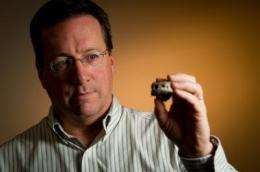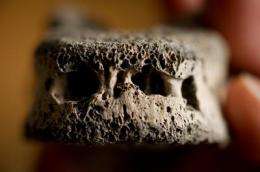Scientists crack medieval bone code

Two teams of Michigan State University researchers – one working at a medieval burial site in Albania, the other at a DNA lab in East Lansing – have shown how modern science can unlock the mysteries of the past.
The scientists are the first to confirm the existence of brucellosis, an infectious disease still prevalent today, in ancient skeletal remains.
The findings, which appear in the American Journal of Physical Anthropology, suggest brucellosis has been endemic to Albania since at least the Middle Ages.
Although rare in the United States, brucellosis remains a major problem in the Mediterranean region and other parts of the world. Characterized by chronic respiratory illness and fever, brucellosis is acquired by eating infected meat or unpasteurized dairy products or by coming into contact with animals carrying the brucella bacteria.
Todd Fenton, associate professor of anthropology, said advanced DNA testing at MSU allowed the researchers to confirm the existence of the disease in skeletons that were about 1,000 years old.
"For years, we had to hypothesize the cause of pathological conditions like this," Fenton said. "So the era of DNA testing and the contributions that DNA can make to my work are really exciting."

Here's how the discovery came about.
Fenton and a group of MSU graduate students were serving as the bioarcheologists, or bone specialists, for a multinational team of archaeologists excavating sites in the ancient Albanian city of Butrint. Once a large Roman colony, Butrint in its final centuries served as an outpost of the Byzantine Empire until it was abandoned in the Middle Ages due to flooding.
Fenton and his team developed biological profiles of the human remains, which included determining sex, age and skeletal pathologies, or health histories. Vertebrae from two of the Byzantine-era skeletons – both adolescent males from the 10th century to the 13th century – had significant lesions, leading the researchers to theorize the boys had suffered from tuberculosis.
Samples of the ancient bone were sent to the forensic DNA lab in East Lansing, which is headed by David Foran, director of MSU's Forensic Science Program. Foran and his team of graduate students took tiny portions of the bone, extracted DNA and tested it for any residual DNA that might still exist from the expected pathogen.
But the results came back negative for tuberculosis.
Fenton's team re-examined the bones that tested negative for tuberculosis and concluded the disease might instead be brucellosis. The infection from brucellosis and tuberculosis causes similar damage – basically eating away the bone – although no one had ever confirmed brucellosis in human bone recovered from an archaeological site.
Foran's team then developed a different set of tests for detecting the brucella bacteria and undertook a new round of testing on the diseased vertebrae.
This time the results came back positive for brucellosis.
Foran said the collaboration on the project highlights the benefits of modern science and interdisciplinary research, even when the respective research teams are some 5,000 miles apart.
"In this case it was a combination of inquisitiveness, persistence and of course collaboration," Foran said. "It is amazing to find something brand new in something that is a thousand years old."
Journal information: American Journal of Physical Anthropology
Provided by Michigan State University

















